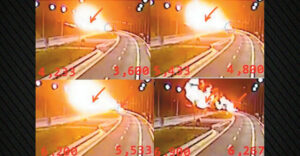Investigation into the Fire’s Origins
New developments have emerged in the investigation into the fireball that followed the train collision in Tempi. The forensic laboratories of the Hellenic Police have confirmed the authenticity of videos showing the freight train just before the crash.
Meanwhile, the Fire Department’s Arson Crimes Directorate is refocusing its attention on the secured lot near Larissa, where the wreckage of the trains involved in the February 28, 2023, collision is stored.
After finally discovering parts of the second locomotive from the freight train—two years after the tragedy—investigators confirmed that it had not burned in the massive fire that broke out immediately after the crash. This rules out the theory that flammable cargo had been placed behind the driver’s seat.
Examining Freon as a Fire Catalyst
Now, fire investigators are attempting to determine what caused the fire that completely incinerated the first passenger car of InterCity 62 (IC 62). In the presence of investigating judge Sotiris Bakaimis, they collected samples from the train’s air conditioning system and sent them to the State General Chemistry Laboratory for analysis.
They are also investigating whether the air chamber of the locomotive’s traction engine played a role in creating the fireball.
Former Hellenic Train CEO Maurizio Capotorto, in a letter dated February 3, 2025, which has been added to the case file, references a technical report stating that the air conditioning refrigerant fluid may have contributed to the explosion.
“Refrigerant fluid is not flammable at room temperature and atmospheric pressure, but it becomes flammable when mixed with pressurized air and exposed to a strong ignition source. Contact with certain reactive metals **can lead to explosive or exothermic reactions under specific conditions,” the report explains.
What the Videos Reveal
Public debate over the fire’s cause is now dominated by the forensic analysis results from the Hellenic Police, which confirmed the authenticity of three recovered videos. These videos show only metal debris in the first three open cars of the freight train, with no evidence of the “suspected flammable material” mentioned in a previous report.
This debunks the theory put forth by technical advisors representing the families of victims, which suggested that many victims were burned alive due to the presence of flammable cargo rather than dying on impact.

The authenticity of the three videos—retrieved from camera 03 and handed over by Interstar on February 5, 2025—was verified through forensic analysis. However, questions remain over why it took nearly two years to recover the footage, despite persistent requests from the investigating judge.
The Suspicion of Flammable Cargo
The theory that illegal flammable cargo was on the freight train gained traction because experts rejected the initial official explanation that the fireball was caused by burning silicone oils from transformers.
For months, no footage was available showing the freight train’s loading process or its movement from Thessaloniki to Larissa. This lack of evidence fueled public suspicion that something was being hidden.
Security officials at the railway company claim they managed to retrieve and upload the footage only after searching hard drives for several hours. However, it remains unclear why this was not done sooner, before public opinion became convinced that the freight train carried hazardous materials that worsened the disaster.
Ask me anything
Explore related questions





